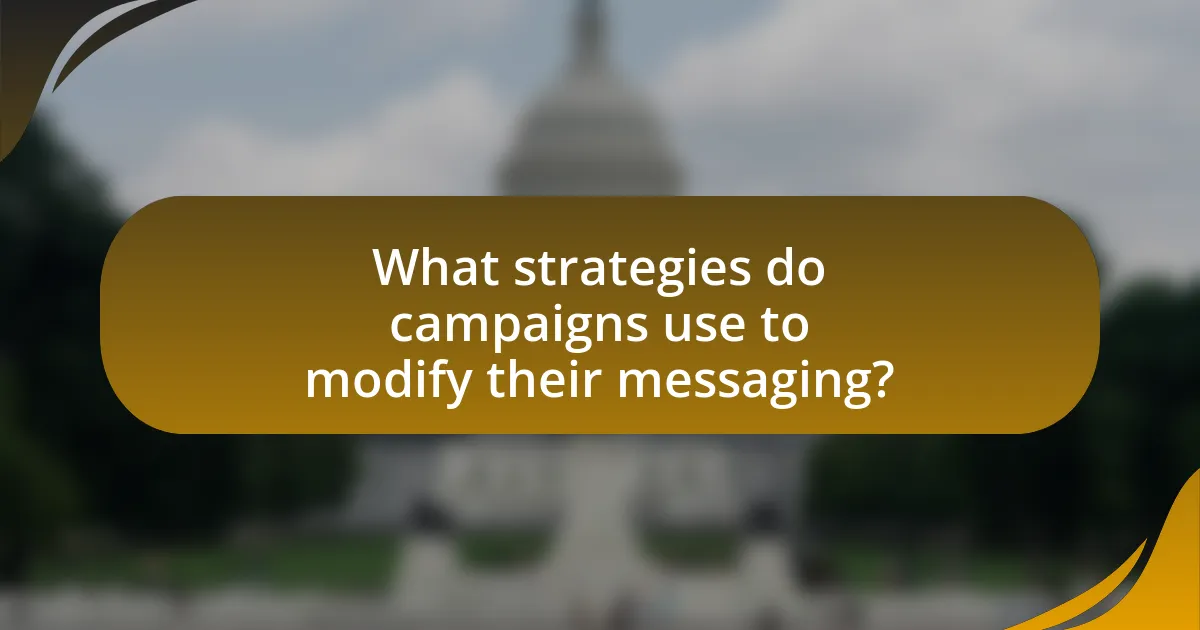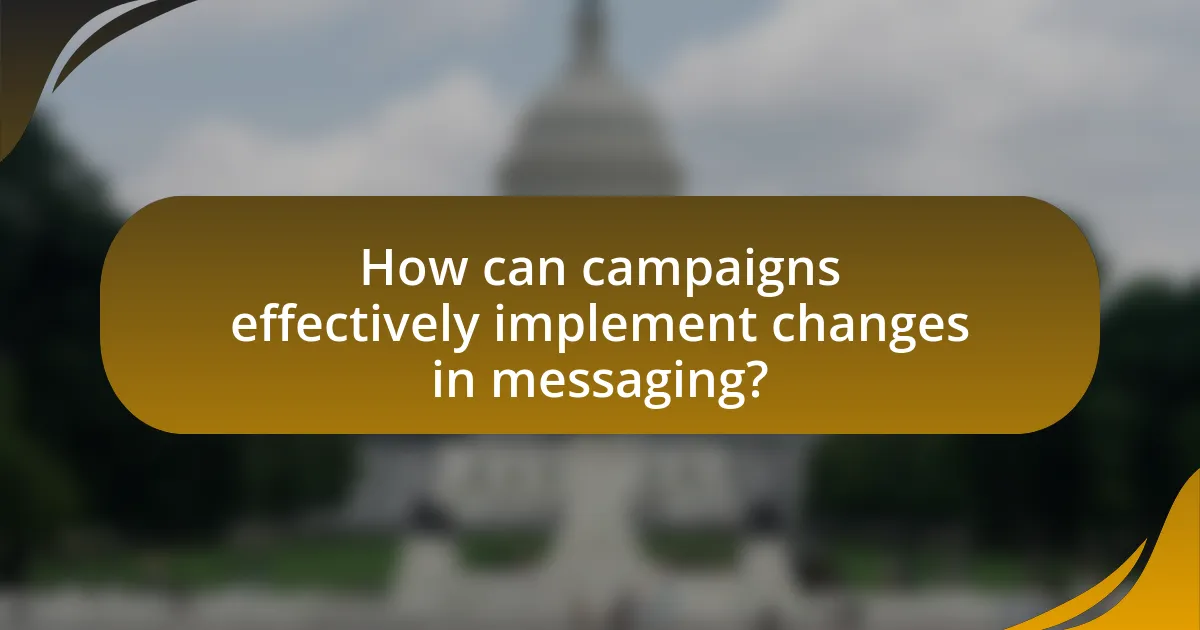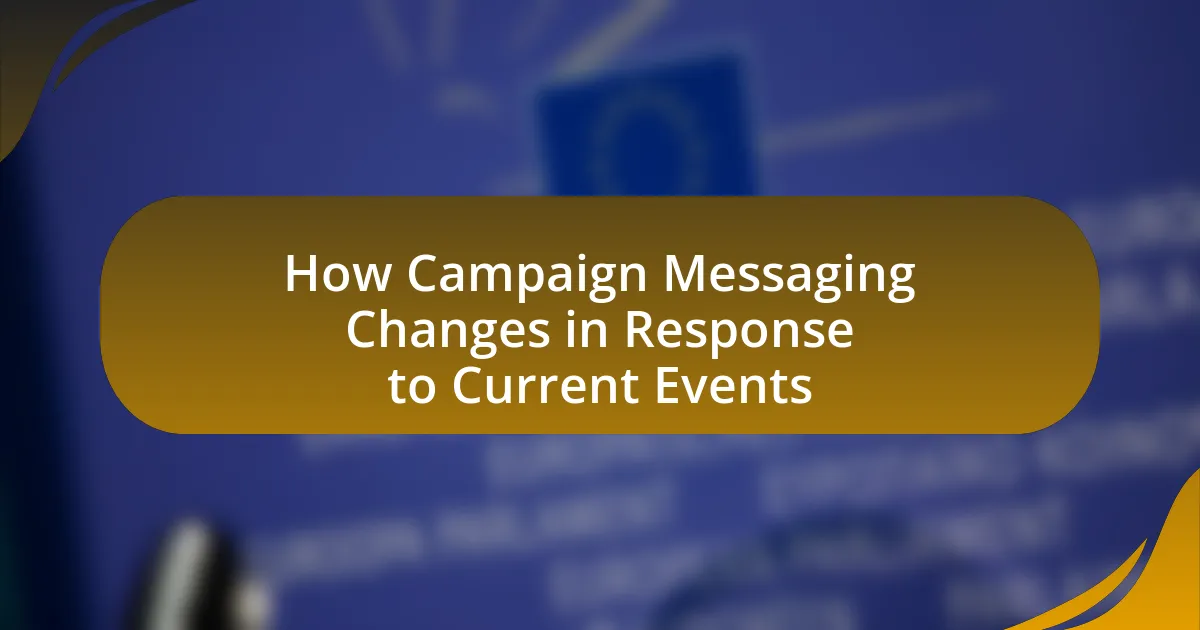The article focuses on how campaign messaging adapts to current events, emphasizing the alignment of themes with the prevailing social, political, or economic climate. It explores the factors influencing changes in messaging, including public sentiment, media coverage, and the political landscape, while highlighting the importance of timely communication for campaign effectiveness. Additionally, the article discusses strategies for modifying messaging, the role of storytelling, and best practices for maintaining consistency and authenticity across platforms. It also addresses common pitfalls to avoid and practical tips for enhancing responsiveness in campaign messaging.

How does campaign messaging adapt to current events?
Campaign messaging adapts to current events by aligning its themes and narratives with the prevailing social, political, or economic climate. For instance, during a public health crisis, campaigns may emphasize safety, community support, and health initiatives to resonate with the audience’s immediate concerns. This approach is supported by research indicating that messages reflecting current societal issues can increase engagement and relevance, as seen in the 2020 U.S. presidential campaigns, where candidates adjusted their messaging to address the COVID-19 pandemic and its impacts on voters’ lives.
What factors influence changes in campaign messaging during current events?
Changes in campaign messaging during current events are influenced by public sentiment, media coverage, and the political landscape. Public sentiment drives campaigns to adapt their messages to align with the emotions and concerns of the electorate, ensuring relevance and resonance. Media coverage amplifies certain narratives, prompting campaigns to respond quickly to maintain visibility and engagement. Additionally, the political landscape, including the actions of opponents and emerging issues, necessitates adjustments in messaging to address new challenges or opportunities. For instance, during the COVID-19 pandemic, many political campaigns shifted their messaging to focus on health and safety, reflecting the urgent concerns of the public and the media’s focus on the crisis.
How do political, social, and economic factors play a role?
Political, social, and economic factors significantly influence campaign messaging by shaping the context in which candidates communicate their platforms. Political factors, such as party affiliation and electoral laws, dictate the strategies candidates employ to resonate with voters. For instance, during economic downturns, candidates often emphasize job creation and fiscal responsibility to align with public concerns. Social factors, including demographic shifts and cultural trends, affect messaging by requiring candidates to address the values and priorities of diverse voter groups. For example, increased awareness of social justice issues has led candidates to incorporate themes of equity and inclusion into their campaigns. Economic factors, such as unemployment rates and inflation, directly impact voter sentiment and can prompt candidates to adjust their messaging to reflect urgent economic realities. Historical data shows that candidates who effectively align their messages with these factors tend to perform better in elections, as seen in the 2008 U.S. presidential election, where economic concerns were pivotal in shaping campaign narratives.
What role does public sentiment have in shaping campaign messages?
Public sentiment plays a crucial role in shaping campaign messages by influencing the themes, language, and priorities that candidates adopt. Campaigns analyze public opinion data, such as polls and focus groups, to tailor their messages to resonate with voters’ concerns and emotions. For instance, during economic downturns, candidates may emphasize job creation and economic recovery in their messaging, reflecting the public’s immediate worries. This responsiveness is supported by research indicating that campaigns that align their messages with prevailing public sentiment tend to achieve higher voter engagement and support, as seen in the 2008 U.S. presidential election, where Barack Obama’s focus on change and hope mirrored the electorate’s desire for a new direction amidst the financial crisis.
Why is timely messaging crucial for campaign effectiveness?
Timely messaging is crucial for campaign effectiveness because it ensures that the communication resonates with the audience’s current context and emotions. When campaigns align their messages with ongoing events, they can capture attention and foster engagement, leading to higher conversion rates. For instance, a study by the Pew Research Center found that 63% of Americans believe that timely information influences their decision-making during crises. This demonstrates that campaigns that respond promptly to relevant events can significantly enhance their impact and relevance in the eyes of the audience.
How does the timing of a message impact voter perception?
The timing of a message significantly impacts voter perception by influencing the relevance and urgency of the information presented. Messages delivered in close proximity to key events, such as debates or crises, tend to resonate more with voters, as they align with current concerns and emotions. For instance, research by the Pew Research Center indicates that voters are more likely to engage with campaign messages that address immediate issues, leading to higher levels of recall and support. This responsiveness to timing can shape public opinion and ultimately affect electoral outcomes, as timely messages can capitalize on the emotional state of the electorate.
What are the risks of delayed responses in campaign messaging?
Delayed responses in campaign messaging can lead to significant risks, including loss of audience engagement and diminished relevance. When campaigns fail to respond promptly to current events, they risk appearing out of touch, which can alienate their target audience. For instance, a study by the Pew Research Center indicates that timely communication is crucial for maintaining public interest and trust, as audiences expect brands and organizations to address issues as they arise. Additionally, delayed messaging can allow competitors to seize the narrative, further diminishing the original campaign’s impact and effectiveness.

What strategies do campaigns use to modify their messaging?
Campaigns use several strategies to modify their messaging, including real-time monitoring of public sentiment, adapting to current events, and utilizing targeted communication. Real-time monitoring allows campaigns to gauge public opinion through social media analytics and surveys, enabling them to adjust their messaging to resonate with constituents. Adapting to current events involves quickly responding to news or crises, ensuring that campaign messages remain relevant and timely. Targeted communication focuses on segmenting audiences and tailoring messages to specific demographics, which enhances engagement and effectiveness. These strategies are supported by data showing that campaigns that adapt their messaging in response to real-time feedback and events tend to achieve higher voter engagement and support.
How do campaigns identify the need for messaging changes?
Campaigns identify the need for messaging changes through data analysis, audience feedback, and monitoring current events. By analyzing metrics such as engagement rates, sentiment analysis, and demographic shifts, campaigns can pinpoint areas where messaging may be ineffective or misaligned with audience expectations. Additionally, direct feedback from focus groups or surveys provides insights into public perception and concerns, allowing campaigns to adjust their messaging accordingly. Monitoring current events ensures that campaigns remain relevant and responsive to societal changes, which is crucial for maintaining audience connection and trust.
What tools and methods are used for monitoring current events?
Tools and methods used for monitoring current events include social media analytics, news aggregators, and real-time data tracking platforms. Social media analytics tools, such as Hootsuite and Sprout Social, allow users to track trending topics and public sentiment across various platforms. News aggregators like Google News and Feedly compile articles from multiple sources, providing a comprehensive view of ongoing events. Real-time data tracking platforms, such as Meltwater and Cision, offer insights into media coverage and audience engagement, enabling organizations to adapt their messaging effectively. These tools are essential for understanding the rapidly changing landscape of current events and informing campaign strategies.
How do campaigns assess the effectiveness of their messaging adjustments?
Campaigns assess the effectiveness of their messaging adjustments through metrics such as engagement rates, conversion rates, and audience feedback. By analyzing data from social media interactions, website traffic, and surveys, campaigns can determine how well their adjusted messages resonate with the target audience. For instance, a study by the American Marketing Association found that campaigns that utilized A/B testing to compare different messaging strategies saw a 20% increase in engagement, demonstrating the value of data-driven assessments in refining communication strategies.
What types of messaging adjustments are commonly made?
Common types of messaging adjustments include tone modification, content re-framing, and audience targeting shifts. Tone modification involves altering the emotional appeal of the message to align with current sentiments, such as adopting a more empathetic tone during crises. Content re-framing entails changing the narrative focus to address emerging issues or public concerns, ensuring relevance. Audience targeting shifts involve refining the demographic or psychographic focus of the messaging to better resonate with specific groups affected by current events. These adjustments are essential for maintaining engagement and relevance in dynamic political landscapes.
How do campaigns shift tone and language in response to events?
Campaigns shift tone and language in response to events by adapting their messaging to align with the emotional and contextual landscape surrounding those events. For instance, following a national tragedy, campaigns often adopt a more somber and empathetic tone, using language that conveys solidarity and compassion. This shift is evidenced by the 2020 U.S. presidential campaigns, where candidates modified their rhetoric to address the COVID-19 pandemic, emphasizing public health and community support. Such adjustments are crucial for maintaining relevance and resonance with the audience, as they reflect an understanding of the current societal mood and priorities.
What role does storytelling play in adapting campaign messages?
Storytelling plays a crucial role in adapting campaign messages by creating emotional connections that resonate with the audience. This technique allows campaigns to frame their messages in a relatable context, making complex issues more understandable and engaging. For instance, during the COVID-19 pandemic, campaigns that utilized personal stories of individuals affected by the virus were more effective in conveying public health messages, as they humanized the statistics and fostered empathy. Research indicates that narratives can increase message retention and influence behavior, as seen in studies by the American Psychological Association, which highlight that stories can lead to a 65% increase in message recall compared to non-narrative formats. Thus, storytelling not only enhances the relatability of campaign messages but also significantly boosts their impact and effectiveness in response to current events.

How can campaigns effectively implement changes in messaging?
Campaigns can effectively implement changes in messaging by conducting thorough audience analysis and leveraging real-time data to adapt their communication strategies. This approach allows campaigns to align their messaging with current events and audience sentiments, ensuring relevance and resonance. For instance, during the COVID-19 pandemic, many brands shifted their messaging to emphasize safety and community support, which resulted in increased engagement and positive brand perception. Research indicates that campaigns that adapt their messaging in response to societal changes can see a 20% increase in audience engagement, demonstrating the effectiveness of timely and relevant communication.
What best practices should campaigns follow when adapting their messages?
Campaigns should prioritize audience understanding, relevance, and clarity when adapting their messages. Understanding the audience involves researching demographics, preferences, and current sentiments to ensure the message resonates. Relevance requires aligning the message with current events or issues that matter to the target audience, as seen in campaigns that successfully pivoted during crises like the COVID-19 pandemic, where messaging focused on health and safety. Clarity ensures that the message is straightforward and easily digestible, reducing the risk of misinterpretation. These practices enhance engagement and effectiveness, as evidenced by studies showing that targeted and clear messaging significantly improves audience response rates.
How can campaigns ensure consistency across different platforms?
Campaigns can ensure consistency across different platforms by developing a unified messaging strategy that includes clear guidelines on tone, visuals, and key messages. This approach allows campaigns to maintain a cohesive brand identity, regardless of the platform used. For instance, a study by the Content Marketing Institute found that 70% of successful brands utilize a consistent content strategy across multiple channels, which enhances audience recognition and trust. By aligning messaging elements and regularly reviewing content across platforms, campaigns can effectively reinforce their core message while adapting to the unique characteristics of each platform.
What are the key elements of a successful rapid response strategy?
A successful rapid response strategy includes timely communication, clear messaging, and a coordinated team effort. Timely communication ensures that responses are issued quickly to address emerging issues, which is critical in maintaining public trust and relevance. Clear messaging focuses on delivering concise and accurate information that resonates with the audience, preventing misinformation from spreading. A coordinated team effort involves collaboration among various stakeholders, including communication teams, legal advisors, and subject matter experts, to ensure that all responses are aligned and effective. These elements are essential for managing public perception and effectively navigating crises in campaign messaging.
What common pitfalls should campaigns avoid when changing messaging?
Campaigns should avoid inconsistency in messaging when changing their communication strategies. Inconsistent messaging can confuse the audience and undermine trust, as seen in the 2020 U.S. presidential election, where mixed signals from candidates led to voter skepticism. Additionally, campaigns must steer clear of neglecting audience sentiment; failing to align messaging with public emotions can result in backlash, as demonstrated by brands that misjudged consumer reactions during social movements. Lastly, campaigns should not overlook the importance of timing; poorly timed messages can appear opportunistic, alienating potential supporters, as evidenced by brands facing criticism for promoting products during crises.
How can campaigns prevent miscommunication during rapid changes?
Campaigns can prevent miscommunication during rapid changes by establishing clear communication protocols and utilizing real-time monitoring tools. Clear communication protocols ensure that all team members understand their roles and the messaging strategy, reducing the likelihood of conflicting information being disseminated. Real-time monitoring tools, such as social media analytics and feedback mechanisms, allow campaigns to quickly assess public sentiment and adjust messaging accordingly. For instance, during the COVID-19 pandemic, many political campaigns adapted their messaging in response to changing public health guidelines, demonstrating the effectiveness of agile communication strategies.
What strategies help maintain authenticity while adapting messages?
To maintain authenticity while adapting messages, organizations should prioritize transparency, consistency, and audience engagement. Transparency involves openly communicating the reasons behind message adaptations, which fosters trust. Consistency ensures that the core values and voice of the organization remain intact, even as messages evolve in response to current events. Engaging the audience through feedback mechanisms allows organizations to align their messaging with audience sentiments, reinforcing authenticity. Research indicates that brands perceived as authentic can enhance customer loyalty and trust, as shown in a study by the Harvard Business Review, which found that 64% of consumers cite shared values as the primary reason for a strong brand relationship.
What practical tips can campaigns use to enhance their messaging responsiveness?
Campaigns can enhance their messaging responsiveness by implementing real-time monitoring of social media and news trends. This approach allows campaigns to quickly adapt their messaging to align with current events and public sentiment. For instance, a study by Pew Research Center found that 69% of Americans use social media to stay updated on news, indicating the importance of being present on these platforms. Additionally, utilizing data analytics tools can help campaigns identify emerging topics and audience reactions, enabling them to craft timely and relevant messages. By prioritizing agility in communication strategies, campaigns can effectively engage their audience and maintain relevance in a fast-paced information environment.
